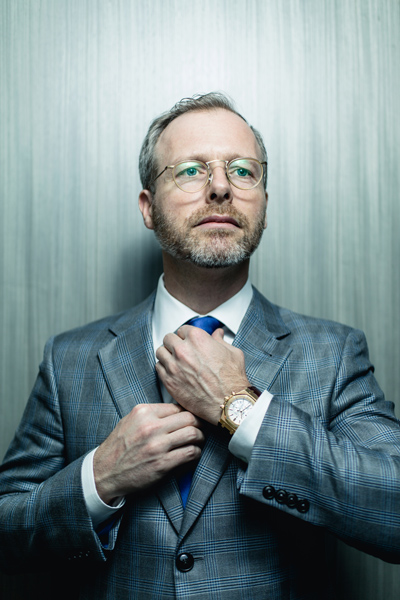Time is a virtue, especially in the world of luxury watchmaking.
But for Xavier Nolot, chief executive officer of the North American division of Audemars Piguet—a century-old luxury Swiss watchmaker—timelessness is even more important for success.
As the retail and technology industries evolve, Nolot works to keep the traditional company true to its roots, which traces back to the 1870s in Switzerland. In 1875, Jules Louis Audemars and Edward Auguste Piguet teamed up to handcraft watches that were complex and filled with artistry. After 140 years, the company is still owned by its founding families. That enduring legacy yields resources the company needs to buck trends and stay true to its customer base.
“We have to be very careful not to talk about volumes or increasing production in the ways our competitors do. we would risk losing our qualitative edge, and our soul, in a sense.”
Audemars Piguet caters to a very high-end clientele with watches costing upwards of $50,000. While many shoppers look for the best online deals before making a new purchase, an Audemars Piguet watch can only be bought in person.
The changing retail market doesn’t worry Nolot, though.“We have to stick to being a niche in the luxury industry,” Nolot says. “We have to keep doing what differentiates us.”
For shoppers, that means visiting one of four boutiques in the United States—in New York City, Las Vegas, Miami, or Waikiki. There are more options in Europe, Asia, Africa, Australia, and the Middle East. “Buying such a product requires the experience that comes with it and that only happens one on one,” Nolot says.
Patrons can also visit the factory in Switzerland where Audemars Piguet watches are made in small workshops with about twenty people working on hundreds of tiny parts for hours at time. Some Audemars Piguet watches have 648 different pieces, just in the movement of the watch alone. “It’s one thing to explain that the product is made by hand, but it’s a small object so it can be difficult to feel the amount of craftsmanship that goes into it,” Nolot says. “But to see it is different. It’s a bit like watching an artist work on a painting. Nothing replaces that experience.”
Quality over quantity is more than just a saying—it is a way of doing business at Audemars Piguet, which produces only about one hundred watches a day.
“We take the opposite route of many businesses. We focus on what we have in quality, design, innovation,” Nolot says. While retail and watch trends are changing fast, Nolot says he isn’t worried about Audemars Piguet’s future. “Watchmaking in a traditional sense is even more valuable because the world is moving so fast,” Nolot says. “The luxury industry is changing. To some extent it is becoming more available to everybody,” he says. “What we make is limited—it’s rare. And rare is part of the definition of luxury in our mind.” That rarity, he says, is what makes the company unique.

It also means that Audemars Piguet doesn’t measure success by its numbers alone. “We have to be very careful not to talk about volumes or increasing production in the ways our competitors do,” he says. “We would risk losing our qualitative edge, and our soul, in a sense.”
The product’s high cost makes the relationship with customers even more crucial, Nolot says. “When you explain to a potential client that this watch is $50,000 and yes, it’s a watch, there has to be a notion of trust established,” he says. Often the people who can afford to buy an Audemars Piguet watch are entrepreneurs or executives who have specific needs that the company strives to meet.
“They are demanding because they have been demanding with themselves first,” Nolot says. “We have to be at their level.”
One way the company is trying to improve that service is by speeding up the amount of time it takes to service a watch. The process now takes between six and eight weeks because each individual watch is completely disassembled, cleaned, and reassembled by hand. In the United States, half of Audemars Piguet’s workforce is dedicated to just servicing the products, Nolot says.
Timelessness also means the leaders of Audemars Piguet want to create timepieces that will be valued decades from now. “That drives everything we do in terms of design, aesthetically and technically,” Nolot says. For example, there are certain materials the company won’t use because it’s possible the materials will not be available thirty years down the road. It also means customers need to be more patient. Shoppers today have gotten used to the fast-paced release of products, often replacing a gadget just months after the last one was bought.
That’s not the case with an Audemars Piguet watch. “If you release all the time you become more fashionable and lose your timelessness,” Nolot says, adding that some designs have stayed the same for the past forty years. “It’s all about timelessness.”
The laser focus on quality is good for customers, but makes running an efficient business difficult, Nolot says. “This is a real challenge because we cannot sacrifice quality for productivity,” Nolot says. “We don’t want to waste money. We want to be more efficient, but always, always with respect to the product we are making.” Productivity would be easier if there were larger volumes of product or processes that could be automated, Nolot says, but every watch at Audemars Piguet is actually crafted by hand.
The company is striving to balance the equation between efficiency and quality without tipping the scales too far in either direction. Educated as a mechanical engineer before he started his career at Audemars Piguet fifteen years ago, Nolot is comfortable navigating that balance between the rational and the artistry, the product and the process.
“It can be very dangerous because we don’t want to risk what we have and what the company was based on, but we still have to live in these times and improve operations,” Nolot says. “Nothing we do is simple. It’s a very delicate approach.”

